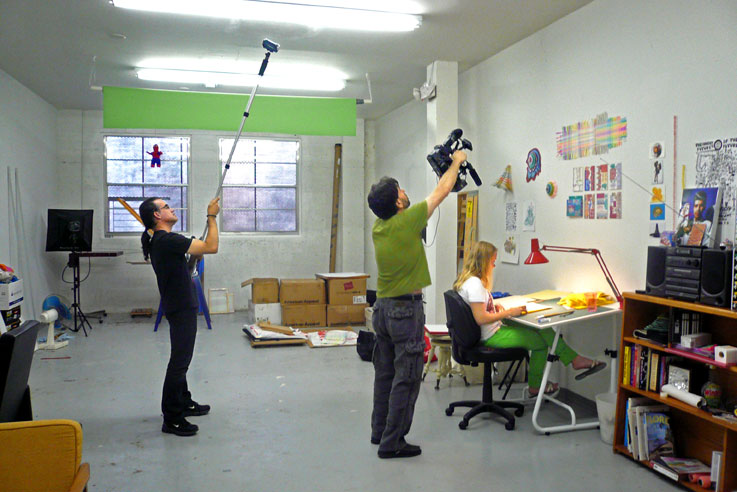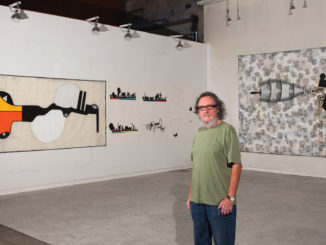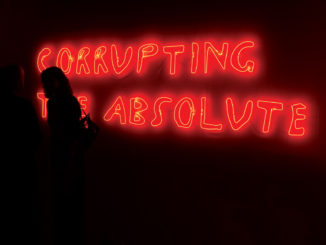The Wet Heat Project creates spirited documentary films, web destinations and events that explore an in-depth experience of the contemporary arts and artists of Miami, capturing history in the making… One story at a time. In the fast-paced Wet Heat video trailer, a rooster sharpens his spurs on the concrete pavement outside a Wynwood warehouse as artist Brian Burkhardt enters his studio space. Inside, butterflies cover the interior panels of a Bucky Fullminster-like geodesic dome where synthetic naturalia blooms under Burkhardt’s nurturing hands. As the artist turns gelatin pill caps into beeswax honeycombs in his greenhouse lab full of artificial insects and faux mushroom spores, the sound of the Jacuzzi Boys perfumes the air.
Burkhardt stoops to weave a spider web on the skeletal armature of a gutted umbrella while the creators of the Wet Heat Project document local art history from the vantage point of a fly on the wall. Burkhardt is one of twenty Miami artists Bill Bilowit and Grela Orihuela have been filming as part of the Studio Drive-By Series for wetheat.tv, a multi-channel production they are launching on their website at the end of November.
Since initiating their project last year they have created short-form documentaries about local artists, dealers, collectors and personalities shaping Miami’s contemporary art scene. Their aim is to offer a “free access, no registration or subscription” Internet resource featuring content focusing on our city’s explosive cultural evolution and the players driving the Big Mango’s hothouse vibe.
Currently, Wet Heat is developing five distinct series of mini documentaries ranging from capturing ephemeral performances, to seminal achievements in an artist’s trajectory, to features on artist couples and interviews with students who have chosen art as their careers.
“It was dynamite,” Burkhardt says of his film experience. “Bill and Grela came to observe me working and I was surprised how intuitive and aware they were about my work. “I think they are playing an important role in documenting the artistic process and are important for Miami’s cultural scene. That’s especially evident when you see how they pair local musicians with artists in these short films.”
Burkhardt adds that Wet Heat is filling a vital gap between some collectors and artists in a generous and productive way. “Bill and Grela’s short films fill the disconnect between the creative process and the finished result. They are showing what an artist’s life is like in a very positive way.”
Orihuela, who moved here with Bilowit in 1996, informs their project was born out of their passion to tell stories as filmmakers, and to experience art.
“Until we moved here, art had not been a big part of our lives,” Orihuela explains. “But the explosive growth of Miami as an art nexus coincided with us living here. So we enjoyed the excitement of this unfolding cultural history, and we participated with our own modest collection. And at the end of last year the timing was right for us to dedicate ourselves to capturing these amazing stories all around us, such dynamic and fascinating personalities on both the artist and the business side.” Before moving to Miami, Orihuela and Bilowit operated “The Show Works” in New York. Their company produced large-scale international corporate events, trade shows and videos for clients that included Sony and Canon.
Before they met, Orihuela produced concerts for Rock impresario Bill Graham and later worked as an executive producer for Telemundo. Bilowit was an Art Director who worked with horror honcho George Romero on Creepshow and cult scare-fare like C.H.U.D. and Sleepaway Camp.
After settling in Miami and immersing themselves in the local arts community, they returned to their creative roots and started Tareco Pictures here, producing music videos and indie films like Round Trip, shot locally and in Tokyo. It featured a cast of homegrown artists, musicians, actors and even a gallerist. They also began collecting art and filling their Key Biscayne home with the works of South Florida talent, many of who have embraced the energetic couple as friends.
For those who have come to know Bilowit and Orihuela it hasn’t come as a surprise that their newest venture Wet Heat, offers an insightful take on a critical moment for our city and the cultural engine driving it. “It’s a great project,” says Nina Johnson, director of Wynwood’s edgy Gallery Diet, where Burkhardt’s impressive geodesic dome installation is currently on display. “They are providing people a venue where they can find clear and concise information on local artists while providing a service for the city.”
An added benefit for artists is that galleries and museums can add Wet Heat video links to their print and email announcements to drum up interest for their shows mentions Johnson. “For Brian Burkhardt’s exhibit, which will be up through Basel, it will help people understand what he’s doing if they don’t have time to visit his studio. These films help collectors and art lovers to immediately understand an artist’s creative practice,” Johnson says.
The videos work like poetry in motion, Bilowit films the artist at work while Orihuela conducts interviews at the end of the process. For the artists the approach allows them to enter a creative zone without pressure.
{mospagebreak}
“Our approach is, we’re going out there on a mission of discovery and the camera’s there to document what we find,” explains Bilowit. “We don’t speculate about what we’re going to find, so the action we capture at each visit is as fresh as possible. We’re not trying to interpret or translate an artist’s work or their comments. We capture a moment of what a Miami artist was working on that day, and get a description of what we saw and how it fits into the current work. We come at this with energetic curiosity, almost as voyeurs.”
Young local dealer Anthony Spinello, who owns an eponymous gallery in Wynwood, believes that the filmmaker’s subtle and candid approach has generated trust among artists and an eagerness to participate in the Wet Heat Project. “They are definitely doing what no one else is in Miami,” says Spinello.
“They are sensitive to the artists and documenting what’s going on without manipulation. They interviewed me for a piece on my first exposure to art and also filmed a performance by Federico Nessi, one of my artists. I was amazed by the cinematography and how they were able to draw out and capture the essence of their subjects in interviews.”
Orihuela observes that every story on wetheat.tv is self-contained and reflects a microcosm of the big picture of South Florida’s cultural growth spurts. “As we build up the content of this project into dozens and dozens of stories on several themes, our audience participates like we do in witnessing this amazing history in the making. They can explore and discover and connect to these stories, people and places at their own pace and time. They can add the insight of what they see to their own opinions and conclusions about Miami’s role in today’s art world – innovator, generator, instigator, host, you name it,” she muses.
Conceptual puppet master Pablo Cano said he was surprised and delighted when Orihuela and Bilowit made a night owl run to his Little Havana studio to film him preparing for his annual marionette production at the Museum of Contemporary Art in North Miami. “For the Studio Drive-By series we catch the artists where and when they’re working, all hours, we never close,” Bilowit laughs. “As Pablo Cano assembled the main character puppet for his annual large-scale show at MoCA, we arrived at his Little Havana workshop at midnight – watching puppets come to life in the middle of the night is especially vivid!”
Cano explains that when Orihuela and Bilowit contacted him to film him working he warned them that he usually began working at midnight and into the wee hours of the morning.
“They showed up in the middle of the night while I was working on my “Blue Ribbon” show for MoCA,” the artist says. “They documented the process and gave me a wonderful little history of me creating one of my puppets and even filmed my little rat terrier Samson at the end of the movie.”
In the film trailer Cano appears in his workshop surrounded by the recycled junk he uses to create his eye-popping marionettes. His recent show at MoCA told the story of a little boy who pins a drawing on a museum wall causing masterpieces from art history to come to life magically. In the Wet Heat video trailer one can see Cano’s whimsical variations on Dali’s melting clocks, Warhol’s tomato can and the Mona Lisa.
“They pretty much caught me the way I work in my environment offering an interesting fly on the wall perspective,” Cano says. “MoCA used the film to promote my show and I put it on my website. A lot of people told me it was a beautiful little glimpse into an artist’s life and process, but what struck me most is Bill and Grela did it voluntarily and for free and they were really quite wonderful.”
Bilowit says what he most enjoys about the Drive-By series is capturing a purely visual narrative, with the interviews as “b-roll” which is the opposite of typical profile documentaries.
“Action shots of the artist at work is our “a-roll” footage; the interviews add some factual and historical context to what we’re seeing,” he explains. “But our effort is for the action itself to capture the moment in a standalone way. The test of having achieved that is a series of very short companion pieces to the Drive-Bys that we call “A-Roll” videos. Each one of these is a really fast-paced whirlwind version of a Drive-By visit cut to the music of a local Miami band or composer. We’ve made five of them and given the link to the artists and their galleries to promote their latest show, which also helps us spread some awareness of who we are, what we’re doing, and the style of enthusiasm and fun in the way we do it.”
Orihuela adds that her favorite aspect of the project is pairing musicians with artists. “Not only is there so much great music in Miami, but there’s a generosity of spirit and sharing, there’s so much support between the music artists in this town, and also between musicians and artists. We were shooting a That Happened episode on a Federico Nessi piece at Spinello that included an outdoor performance, and as I watched a big crowd accumulate on the street I saw many artists that came out to support Federico. People were there for each other. That kind of spirit is part of what gives art in this town its overall character, a certain kind of inventiveness and openness that’s only possible when you know you’ve got genuine support out there,” Orihuela smiles.
The couple will be launching wetheat.tv in later this month with several episodes of the Studio Drive-By series, Season One and adding new episodes frequently through the winter. They will also be collaborating with Locust Projects for their booth at Pulse Contemporary Art Fair during Basel, creating a self-powered video interview booth and will be premiering miamiHeights profiles of Hernan Bas and Bert Rodriguez in early 2009.
You can catch them at www.wetheatproject.com




Be the first to comment